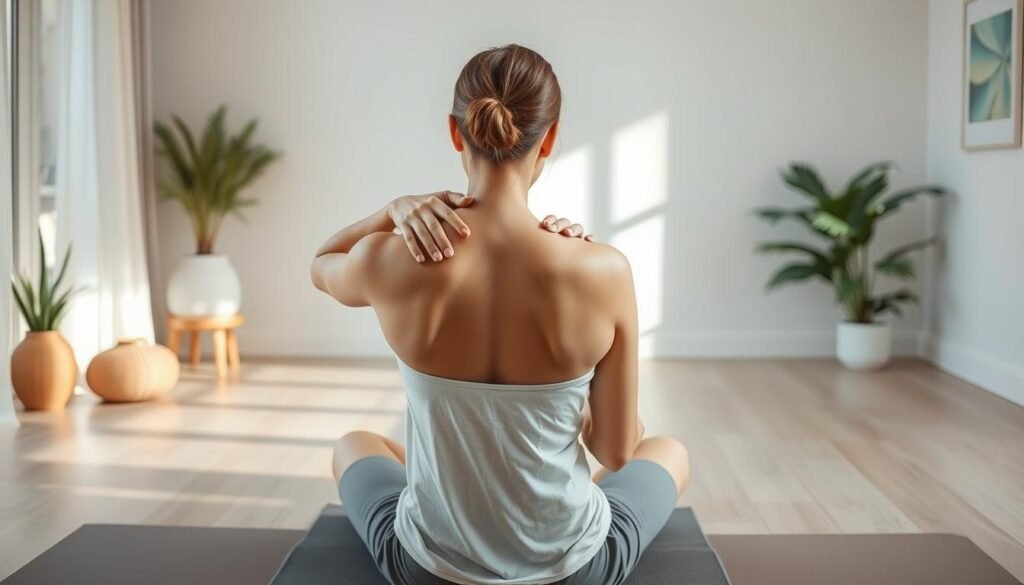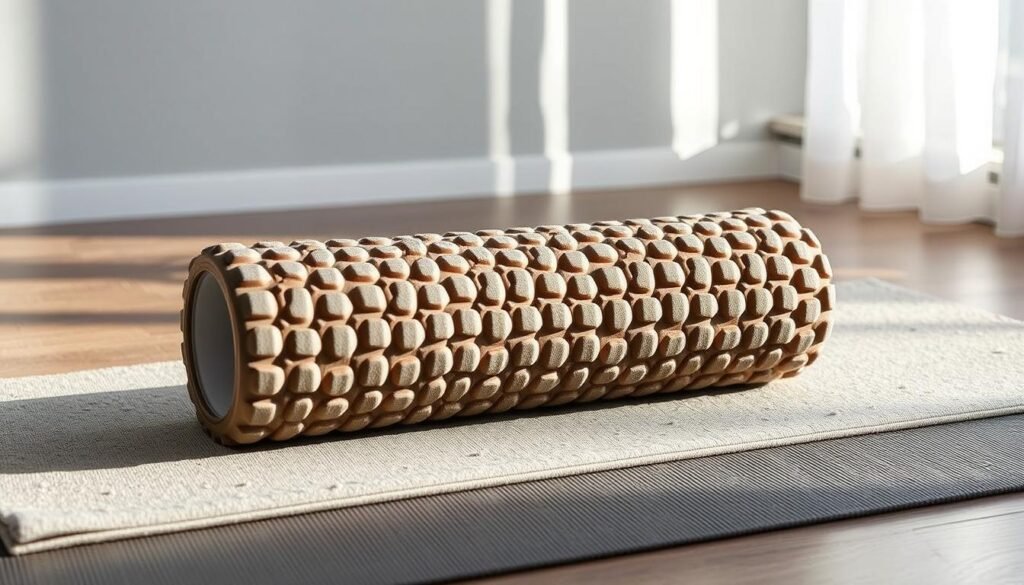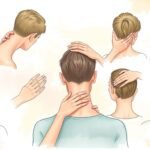Ever wondered why that pain in your upper back lingers? It might be your trapezius muscle. Learning to massage it could bring relief. I’ve found that knowing this muscle is key to self-care.
The trapezius muscle, shaped like a triangle, runs from your skull to your mid-back. It’s vital for everyday movements. But when it’s tight, it can be very uncomfortable. Don’t worry, I’ll show you how to ease that tension with massage techniques.
In this guide, I’ll share tips on easing trapezius muscle tension. You’ll learn how to massage it effectively. These methods can help with stress-induced tightness and improve your overall well-being.
Key Takeaways
- The trapezius muscle extends from the skull to the mid-back
- Tension in this muscle can cause neck and shoulder pain
- Proper massage techniques can significantly relieve discomfort
- Self-massage is an effective way to manage trapezius tension
- Regular trapezius care can improve overall upper body well-being
Understanding the Trapezius Muscle
The trapezius muscle is key for our daily movements and posture. It’s a big, triangular muscle that covers the upper back, neck, and shoulders. Let’s explore its anatomy, what causes tension, and signs of strain.
Anatomy and Function
The trapezius has three parts: upper, middle, and lower fibers. Each part does something different:
- Upper fibers: Elevate and rotate the shoulder blades
- Middle fibers: Retract the shoulder blades
- Lower fibers: Depress and rotate the shoulder blades
Common Causes of Trapezius Tension
Traepezius muscle knots can come from many things. Some common causes are:
- Poor posture
- Prolonged desk work
- Stress and anxiety
- Overuse during physical activities
- Sleeping in awkward positions
Signs of Trapezius Muscle Strain
Knowing the signs of trapezius strain is important for quick relief. Look out for:
| Symptom | Description |
|---|---|
| Pain | Dull ache or sharp pain in the upper back or neck |
| Stiffness | Reduced flexibility in neck and shoulder movements |
| Muscle knots | Hard, sensitive lumps in the trapezius area |
| Headaches | Tension headaches originating from the neck |
Knowing about the trapezius muscle helps with effective upper back massages. Regular self-care and good ergonomics can stop many problems with this muscle group.
Benefits of Trapezius Muscle Massage
Trapezius muscle pain relief is key for those with upper back and neck discomfort. An upper back massage for trapezius offers many benefits, more than just relaxation.
Getting a trapezius massage boosts blood circulation right away. This helps muscles recover faster, especially after hard workouts or long desk hours. It also cuts down swelling, great for those with heavy bags or bad posture.
Regular massages have also improved my posture. They help me stay aligned, lowering injury risks. Plus, I can move my neck and shoulders more freely, making daily tasks simpler.
Surprisingly, trapezius massages have also made my sleep better. The tension relief means I sleep more soundly and wake up less stiff.
| Benefit | Impact |
|---|---|
| Improved circulation | Faster muscle recovery |
| Reduced swelling | Less discomfort from daily activities |
| Better posture | Decreased risk of future injuries |
| Increased range of motion | Easier everyday movements |
| Enhanced sleep quality | More restful nights |
For those with tension headaches, trapezius massages can be a big help. I’ve seen a drop in headache frequency and intensity. As a bonus, the massages have also eased ear ringing and jaw pain caused by trapezius tension.
Preparing for Your Trapezius Massage

Getting ready for a trapezius massage is important. I’ll show you how to set up the right space, pick the best products, and find the best position.
Creating the Right Environment
A calm space is key for a good massage. I dim the lights and play soft music. I also use aromatherapy to create a relaxing mood.
Choosing Massage Oils or Lotions
Choosing the right massage product is important. I like natural oils like jojoba or almond. Adding a few drops of essential oils can help too.
Lavender oil helps me relax, while peppermint gives a cool feeling on my trapezius muscle.
Proper Body Positioning
Getting into the right position is crucial. I sit in a chair with good back support. This lets me easily reach my trapezius without straining.
If I’m using both hands, I stand or sit on the edge of a bed. This gives me better access to my upper back.
By preparing well, my self-massage for trapezius muscle relief works better. A good setup and the right position make a big difference.
How to Massage the Trapezius Muscle
Learning to massage the trapezius muscle can ease tension and help you relax. I’ll show you how to find and massage this key muscle area.
Locating the Trapezius Muscle
The trapezius muscle covers your upper back, shoulders, and neck. To locate it, cross one arm over your chest and touch your opposite shoulder. The spot you touch is your trapezius.
Basic Massage Techniques
To massage the trapezius, start with soft circular motions. Use your fingertips or knuckles for pressure. Start at the neck base and move to your shoulders.
Knead the muscle like dough, adjusting pressure as needed.
Pressure Points and Trigger Points
Find tender spots or knots in your trapezius. These are trigger points. Press these areas for 10-15 seconds. Then, release and repeat.
This method can reduce muscle tension and pain.
- Use slow, rhythmic movements
- Adjust pressure based on comfort
- Focus on areas that feel particularly tense
Effective trapezius muscle massage takes practice. Be patient and listen to your body. If pain persists, seek professional help.
Self-Massage Techniques for the Trapezius

I’ve found that self-massage for trapezius muscle tension can be a game-changer. It’s an easy way to relieve discomfort and improve flexibility right at home. Let me share some effective techniques I use to ease trapezius muscle strain.
First, I locate the trapezius muscle. It’s the large, triangular muscle that spans from the base of my skull to my mid-back. I use my fingertips to apply gentle pressure in circular motions. This helps in relieving trapezius muscle tension.
Next, I focus on specific areas of tightness. I spend about 30 seconds on each spot, gradually increasing pressure as needed. Using both hands allows me to work on my shoulders and neck simultaneously, enhancing the effectiveness of the massage.
Between massage movements, I incorporate gentle stretches. This combination of massage and stretching significantly improves my muscle flexibility and relaxation. I make sure to breathe deeply throughout the process, which aids in releasing tension.
For best results, I perform this self-massage routine daily, especially after long periods of sitting or physical activity. It’s become an essential part of my self-care routine, helping me maintain a relaxed and pain-free trapezius muscle.
Incorporating Tools for Deeper Massage

Trapezius muscle knots can be tough to deal with. But, the right tools can make a big difference. I’ve found that using different massage aids helps target those tough spots. It provides trapezius muscle pain relief better than hands alone.
Using Tennis Balls or Massage Balls
Tennis balls or specialized massage balls are great for finding specific areas of tension. I place a ball between my back and a wall, then lean against it and roll slowly. This helps break up knots and increases blood flow to the trapezius area.
Foam Rollers for Trapezius Relief
Foam rollers are versatile tools for trapezius muscle pain relief. I lie on the floor and place the roller under my upper back. Gently rolling back and forth helps release tight muscles and improves flexibility in the trapezius region.
Electric Massage Devices
For deeper tissue stimulation, electric massage devices are my go-to choice. These tools offer various settings and attachments to target trapezius muscle knots effectively. I find them especially useful for hard-to-reach areas of the upper back.
| Tool | Best for | Ease of Use |
|---|---|---|
| Tennis/Massage Balls | Specific knots | High |
| Foam Rollers | Overall muscle release | Medium |
| Electric Devices | Deep tissue massage | Low |
By adding these tools to my routine, I’ve seen a big improvement in managing trapezius muscle pain and reducing knots. It’s key to start gently and gradually increase pressure as you get more comfortable with each tool.
Stretches to Complement Trapezius Massage
Adding stretches to your routine can boost the benefits of massage. It helps in easing trapezius muscle tension. I’ve seen that mixing stretches with massage boosts flexibility and lowers the chance of future tension.
Here are some effective stretches you can try:
- Shoulder shrugs: Lift your shoulders towards your ears, hold for 5 seconds, then release. Repeat 10 times.
- Neck rotations: Slowly rotate your head in a circular motion, 5 times clockwise and 5 times counterclockwise.
- Arm circles: Stand with arms extended to the sides, make small circles forward for 10 seconds, then backward for 10 seconds.
Do these gentle stretches all day, especially after sitting for a long time. It keeps your muscles flexible and stops tension from building up in your trapezius muscles.
To get the most out of it, try this routine:
- Start with a gentle massage to warm up the muscles
- Perform the stretches listed above
- Follow up with another short massage to further relax the muscles
By adding these stretches to your daily routine, you’ll see a big improvement in easing trapezius muscle tension. Always listen to your body and don’t stretch too hard.
When to Seek Professional Help
Self-massage can help with trapezius muscle pain, but sometimes I need a pro. It’s important to know when my trapezius issues are more than just stress.
Signs of Serious Trapezius Issues
I watch for signs that mean I should see a doctor. If my trapezius pain lasts over two weeks or affects my daily life, it’s a sign. Sudden shoulder pain, fever, or swelling around my trapezius area are also reasons to seek help quickly.
Benefits of Professional Massage Therapy
When my trapezius muscle trigger points are tough to get rid of, a professional massage therapist can help. They have special techniques to target those stubborn knots and ease chronic tension. They also teach me how to manage my trapezius muscle pain relief at home.
Getting professional help is not just about fixing pain. It’s also about preventing future problems. Massage therapists can spot potential issues before they become big problems. That’s why I don’t hesitate to book an appointment when my trapezius needs extra care.
FAQ
What is the trapezius muscle and what are its functions?
What causes trapezius muscle tension and what are the signs of strain?
What are the benefits of trapezius muscle massage?
How can I prepare for an effective trapezius massage?
How do I locate and massage the trapezius muscle?
What are some self-massage techniques for the trapezius?
What tools can be used for deeper trapezius massage?
What stretches can complement trapezius massage?
When should I seek professional help for trapezius issues?
Source Links
- How to Self-Massage Your Trapezius Muscle – https://www.verywellhealth.com/trapezius-muscle-pain-massage-technique-296996
- How to Self-Massage Trapezius Muscle – https://www.littlemumcare.com/blogs/front-page/how-to-self-massage-trapezius-muscle
- A Simple Guide To Head-To-Toe Self-Massage – https://www.thegoodtrade.com/features/self-massage-tips/













8 Comments
Though this guide is great, anyone else wonder if daily trapezius self-massage could lead to over-relaxation of the muscle? Just a thought!
Does anyone else think that the article overlooked the importance of proper posture in preventing trapezius tension? Just a thought!
Interesting read! But, is there a specific technique for massaging the trapezius to avoid further tension? Little clarity would be great!
Do you think doing trapezius massages daily could reduce overall stress levels? I mean, its a big muscle affecting posture, right?
Absolutely! Daily trapezius massages can significantly alleviate stress. Good posture equals less stress!
Interesting guide but isnt it hard to effectively massage your own trapezius muscle without professional help? Just a thought.
So, does anyone else think that the trapezius muscle is underappreciated in our daily posture awareness? Just me? Okay then…
Absolutely agree! Trapezius muscle is the unsung hero of good posture!